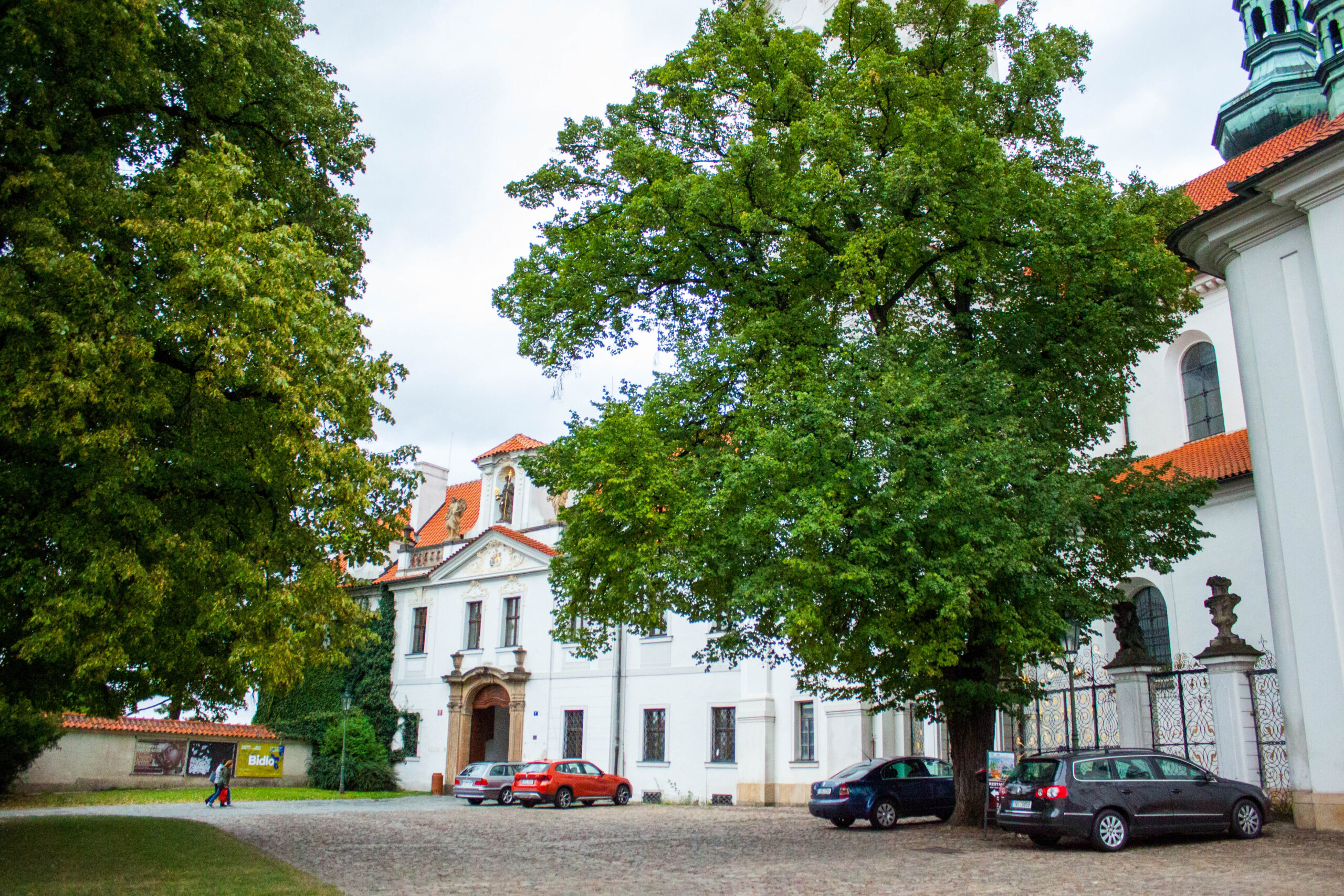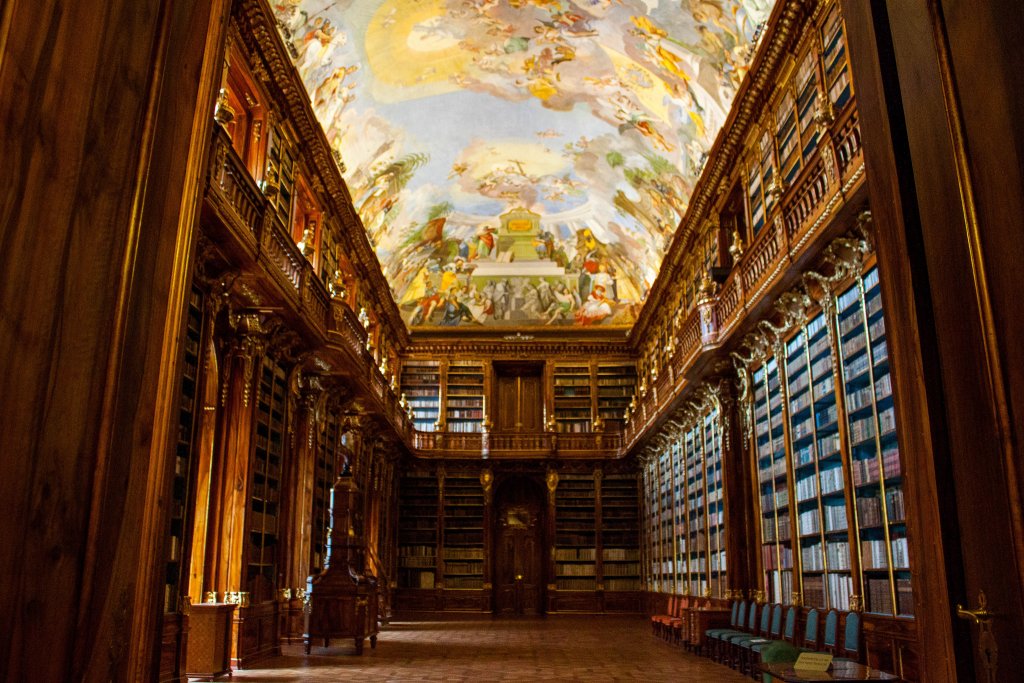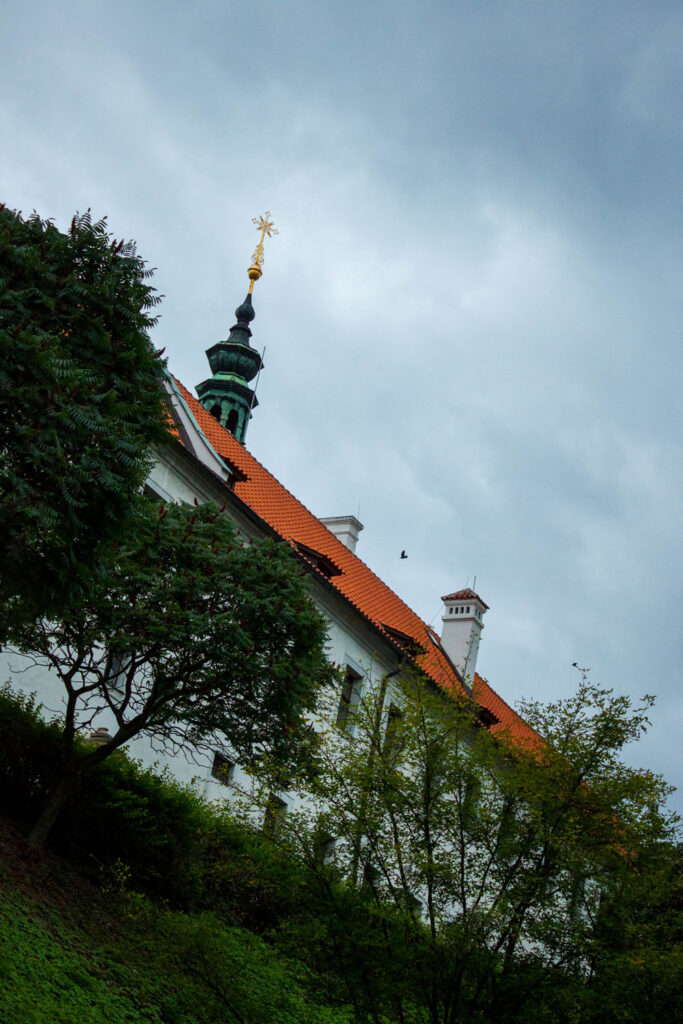

As someone who is slowly making her way through a bucket list of visiting ‘The Greatest Libraries in the World‘, getting to explore the Strahov Monastery in Prague and their illustrious shelves of parchment treasures, was a dream come true.




The Strahov Monastery was first established in 1140. Throughout the years it was destroyed and rebuilt, time after time, war after war. Many of their precious books were stolen, and despite this, every time they rebuilt it, they sought to rebuild their libraries, even grander. Creating a space of importance and preservation for the tombs within. Today, the Monastery and the library stand as a jewel of the Baroque era. Even from afar their bright red-tiled roofs and copper spires, aged to a brilliant teal colour, contrast the grey skies.
To get to the library, walk across the Charles Bridge to board the #22 Tram and ride it to the stop ‘Pohořelec’. From this stop it’s only a 5 minute walk downhill to get to the library. Alternatively, take in the monastery as a part of my Petrin Hill Self-Guided Walking Tour!
As you ascend the hill towards the main building, you first pass another piece of the Monastery’s history; its brewery. This brewery was established in the 1600’s, and the monks would work and produce beer to create income their order. Even today you can visit the brewery and drink a glass sitting in their scenic beer garden. We made sure to make a pit stop here before heading to the library. Like all beer in Prague, it is cheap and delicious! And the view is unbeatable, look out over the valley and across to Prague Castle.
The entry price for visiting the Library and Pictures gallery is CZK 120, and there is a small photo fee if you want to take pictures. While some people complain about this cost, I love this feature. Some places don’t let you take pictures at all, but here, by charging a small fee, it can control the cameras in the museum and helps bring in a little more money to ensure proper preservation the delicate pages inside against those harsh flashes that people inevitably use. The library is open daily from 9am to 5pm (with a one hour lunch break from 12pm-1pm when it is closed). Last admission 30 minutes before closing.
The library has three parts which visitors can explore. The Grand Philosophical Hall, The Baroque Theological Hall and the Cabinets of Curiosities. After paying admission to a surely looking Czech woman inside an ancient wooden toll booth, you are allowed to head the old stone staricase towards the library.
The first room you enter inside the Monastery is the Viewing Gallery. This room contains dozens of timeworn books, preserved in glass cases. The most important, beautiful and rare book of the collection, as well as one of the oldest, is the Strahov codex. The codex was rebound with red velvet in around 1180 and decorated with four enamel Romanesque carvings and six large red and white crystals. A sculpture of Christ on the Cross, Our Lady and St John, along with four silver Renaissance medallions of the evangelists were also added to create one of the most stunning book covers I’ve ever seen.
Behind the glass in the other cabinets, you can see the masterful art works within the pages of this book. This codex older than the Czech state itself, dating from 860-865. There are between 980 and 985 full page drawings of the evangelists. The illustrations contained within were painted by some of the great masters of book illustrations in the Ottoman empire.
In medieval times, before the printing press, the only way of getting text into books was to write it by hand. This was mostly done by Monks of the order. Since these Bibles and Holy tombs were handmade, they were extremely expensive. But they were most than just words; they were works of art. So much time, care and artistry were put into each unique treasure. The monks were incredibly talented, and each of the tiny painted scenes hidden on each piece of parchment brought the story alive to the readers. In addition to the codex, there are various other illustrated books from the medieval period depicting subjects like religion, mythology and even geography inside the glass cases in the entry.
The Grand Philosophical Hall is the jewel of the monastery. Looking from floor to ceiling at this ornately designed library will literally take your breath away. It contains over 42,000 ancient philosophical texts, sprawling along the room like a wave of knowledge. The room was designed in 1794 by Jan Ignác Palliardi, an Italian architect living in Bohemia. He used elements of the previous, smaller library, when creating his final vision. This preserved the beautiful old walnut interior for the previous library.
The sheer size of this library is what first hits you. It is 32 meters long, 22 meters wide, with a ceiling height of 14 meters. Your eyes are not doubted drawn right up to the bright and action packed frescos above. These were done by the Viennese painter Anton Maulbertsch, who spent over six months working with only one other artist to complete the stunning scene.
The painting depicts the ‘Intellectual Progress of Mankind’ and shows developments in science and religion, and their mutual impact on each other. It also represents man’s quest for knowledge and his drive to learn the secrets of the universe. We can see Noah building the ark, Cain and Abel as well as the evolution of Greek civilization. There are philosophers standing guard; Socrates and Diogenes as well as leaders like Alexander the Great. There are two levels to the library. The main level with rolling staircase to access the books at the very top of the shelves, and a gallery only accessible from a hidden spiral staircase. The staircase looks like the spines of books but is, in fact, simply painted onto the wooden door.
Between the Philosophers hall and the theological hall, you’ll come across various cabinets of curiosities. This particular collection was from the estate of Karel Jan Erben, brought to the monastery in 1798. These cabinets are tiny museums. Wealthy collectors had the ability to buy different items that interested or amused them and assemble it all together in these gilded cabinets. They would then invite friends over to admire their collection and tell stories about the various pieces within. To these people, it was the height of entertainment.
In the Renaissance when these cabinets first began to pop-up, the most popular items in the collections were mysterious or remarkable objects. Then, obsession moved onto natural sciences, like collections of sea fauna. There were insect collections, mineral samples, and wax replicas of fruit. One of rarest things in the collection is the prepared remains of, the now extinct, Dodo bird. There are weapons and armour from Bohemia as well as ceramics, sculptures and more. One of my favourite cabinets contains a ‘dendrology’ library. 68 volumes prepared by Karel of Hinterlagen from around 1825 full of different types of wood! Seems pretty dull but I love when people have something, even something mundane, that they are obsessed with.
The Theological Hall is down the long hallway from the Philosopher’s Hall. This gallery contains over 18,000 religious texts. Many of the books included are rare volumes seen only by the monks and approved scholars. The room is named ‘Theological Hall’ after the fact that it contains nothing but different editions of the Bible or parts of the Bible in all different languages. The Theological Hall was built in 1671 by architect Giovanni Domennico Orsi, a Prague burgher of Italian origin. The Italian influence can be seen throughout the design of the library, especially in all the stucco touches above the shelves.
The bookshelves are gilded wood with carved decoration. The use of red throughout related to the ‘sacred’ as these books were considered some of the most sacred things in their time. Although we look at the use of upright shelves in the library as the norm now, Baroque designers were the first ones to use the upright shelf design compared to the Gothic desk system or Romanesque treasury system.
Above the shelves of the Theological Hall are gilded wooded-carved decorations inside wooden cartouches. These functioned as a sort of early card cataloguing system. The pictures in the wooden cartouches specified the type of literature stored on the shelves below. Above all the shelves is magnificently painted fresco. The mural portrays the ethos of the library that a person with great faith must also build on his knowledge and provide education for those who need it, sharing his learned knowledge with the world. There is a piece of script carved into the iron gates on the other side of the library which states INITIUM SAPIENTIAE TIMOR DOMINI (the beginning of wisdom is fear of God.) Along the centre of the room are a series of 17th-century geographical and astronomical globes.
One of the most important objects in the room is the late-Gothic wooden statue of St John the Evangelist. In his left hand, he holds a real ‘girdle-book’. These girdles were used as carrying cases for the treasured objects, in this case, books, as people travelled from city to city, reading to the common folk. The beautifully stitched and sewn carving of the girdle depicts the care that was taken in the protection of books in the medieval area. So much time and effort was taken into creating them; you had to be so careful when taking them out of the libraries arms.
The Strahov Monastery Library is one of those places that is often overlooked by the majority of travellers who come to Prague, so even if you’re not a bibliophile, this is a perfect place to soak in some beautiful architecture, gorgeous art and escape the crowds. If only for a moment.
Paris transforms into a magical wonderland from November to January, bursting with festive charm and…
French cuisine is one of the coziest delights to savour in winter. With its hearty…
During the festive season, Paris becomes a sparkling holiday dream, with twinkling fairy lights cascading…
When it comes to Christmas shopping, Paris is pure magic—a city where elegance meets holiday…
There’s nothing quite like Paris at Christmastime—the City of Light transforms into a glittering wonderland,…
There’s something undeniably magical about Paris at Christmas. Sure, the City of Light is enchanting…
This website uses cookies.